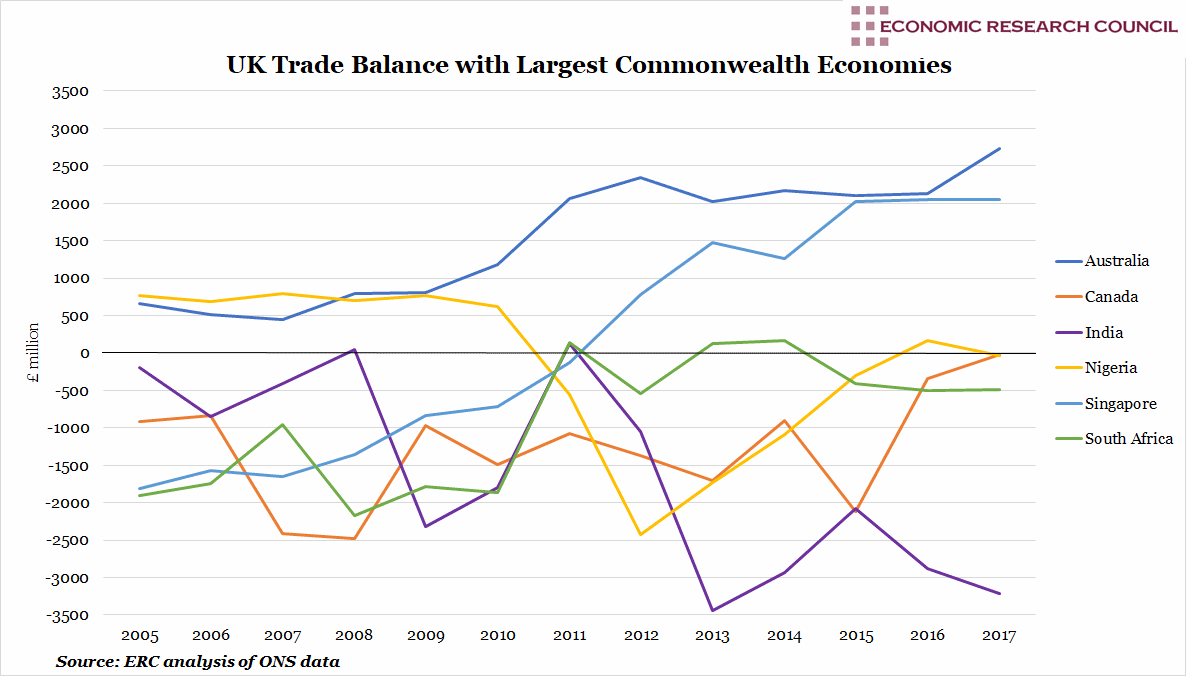
Summary
The average of combined exports to the selected countries has increased 1.7 times, while the average imports from them have increased by 2.7 times over the time period shown. The largest increase in imports to the UK was from Nigeria, where there was an almost 10-fold increase between 2005 and 2017. The highest increase in exports from the UK was to Singapore, an increase of 2.5-fold over the same period. The shifting of the trade balance from deficit to surplus with Singapore has resulted in an increase of almost £4 billion to the UK economy since 2005. Australia is the only economy shown where the UK was consistently a net exporter between 2005 and 2017. The UK was consistently a net importer from Canada and predominantly a net importer from South Africa, with short periods of change in 2011 and between 2013 and 2014. Britain is also a net importer from India, the largest commonwealth economy, with significant peaks and troughs in their trade balance every two years.
What does the chart show?
The chart shows the trade balance between the UK and selected commonwealth countries, focusing on the six largest commonwealth economies. The data measures both goods and services in £ millions seasonally adjusted, between 2005 and 2017. The data originates from the Office of National Statistics.
Why is the chart interesting?
Approaching Brexit, there has been a strong emphasis on strengthening Britain’s global trade ties, particularly with its former colonies. The Commonwealth Heads of Government meeting in London earlier this year discussed the importance of intra-commonwealth trade, focusing on boosting employment and investment, and including the smaller economies.
The UK currently exports almost five times as much to the EU than all of the commonwealth nations combined. Additionally, the overwhelming majority of commonwealth members expressed desire for the UK to remain inside the EU. This could be because the UK is viewed as a potential gateway to European trade. The commonwealth nations’ diverse economies and large, ever wealthier population (one third of the world’s population) could be a boon to UK exports post Brexit, tempering any impact from Brexit-related limitations to UK-EU trade. As a net importer, it would be prudent for UK’s trade policy to prioritise the securing of low-tariff goods on which to rely should a need for retaliatory tariffs on EU goods arise.
Looking at the Asian nations shown on the chart, the UK appears to view Singapore as a gateway to the ASEAN market. In 2018, 4,000 British companies employed over 50,000 people in the city-state, although UK trade with Singapore has been predominantly financial services -focussed. While India may be the largest commonwealth economy, its markets have high barriers to entry and their leadership have expressed ambivalent attitudes towards trade deals with non-Asian markets. India’s tariffs on whisky, access to legal and insurance markets, and restrictions on work visas pose the largest hurdles in the way of stronger UK-India trade ties.
On a visit to Nigeria this past summer, UK Secretary of State Penny Mordaunt expressed desires to shift from the current aid-based relationship towards a stronger trade and investment environment with the nation. The UK currently spends £300m on foreign aid in Nigeria, the third largest recipient of British aid after Pakistan and Ethiopia. Theresa May also made a visit to Sub-Saharan Africa this past summer. During her speech in South Africa, she announced that the UK aims to be the top investor in Africa out of the G7 nations. UK imports fuel, precious stones and fresh fruit from these nations and is increasingly interested in investing in their energy sector, a shared interest with the US.
Already existent strong trade ties between neighbouring nations could potentially prove limiting for Britain’s trade expansion. For example, Canada’s strongest trading partner is the US, with much of their existing trade policy oriented towards them. Australia and New Zealand are strong trading partners amongst themselves, and historically have seemed more interested in trade and investment with China and other emerging Asian markets. These trends relate to the ‘gravity model’ of trade, means that the larger and closer trading partners are, the higher their volume of trade. However, apart from geographical proximity, shared language, historical links and free trade association membership are also significantly influential factors.
Britain could potentially look to China as a model for expanding trade with the commonwealth nations. In the decade starting 2006, China’s trade with all commonwealth nations grew by over 8-fold, and is currently valued at almost £200 billion. This appears largely due to Chinese interest in power plants, motorways, food, steel and solar panels. However, it is important to consider the vast differences in economic policy, population, resources and geography between the two countries as potential limitations for Britain.
Week 44, 2018

